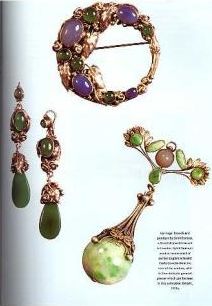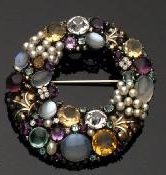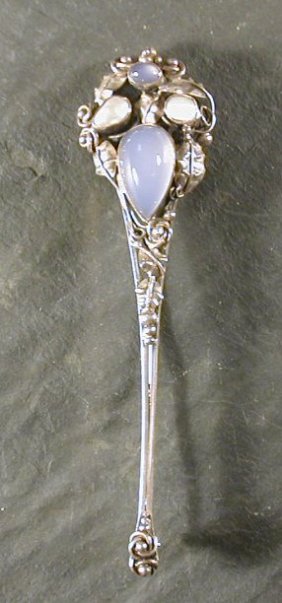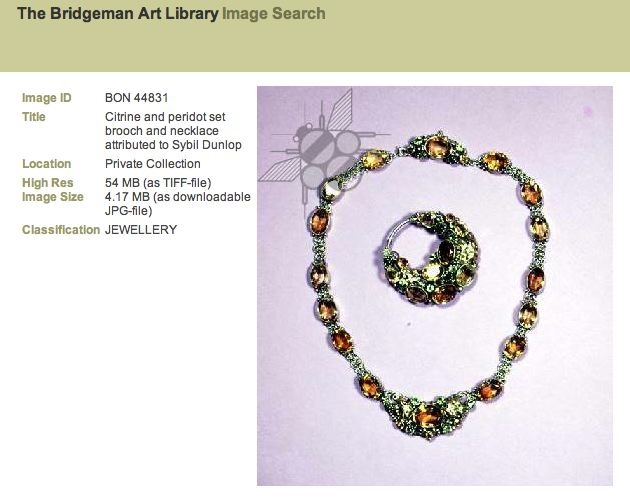Authors of books on jewellery are not the only culprits auctioneers are equally at fault in their attributions. Many books, jewellery dealers, online catalogues for auctions and sales often misattribute items. Thankfully some authors are not quite so dogmatic and hedge their bets with “. . . may be the work of Sybil Dunlop, . “ (Bury S 1991 p255) or “An Arts and Crafts pendant necklace attributed to Sibyl Dunlop or Dorrie Nossiter” (Lyon & Turnbull 2003).
Case1
Caroline Pullée in her book on ‘20th Century Jewelry’ includes a plate with the caption,“Earrings, brooch and pendant by Sybil Dunlop, a scottish jeweller based in London. Sybil Dunlop’s work is reminiscent of earlier English Arts and Crafts jewelry from the turn of the century, with its fine delicate gem set pieces which can be seen in this collection. Britain 1920’s" (Pullée C. 1990 p17).The trouble is that only one of these pieces was designed by Sybil Dunlop, the pendant which is very much symmetrical in nature, with other pieces showing the classic floral and leaf combination favoured by Dorrie.
Lower right is by Sybil Dunlop all the others are by Dorrie Nossiter but incorrectly attributed.
Misattribution by Becker 1987.
Case 2
Misattribution by Becker V (1987), the centre ring is more likely by Dorrie Nossiter with scrolls and naturalistic leaves, but exact attribution is difficult with the quality of the image and its concentrating on a group rather than individual pieces.Case 3
Mistattribution by Bayer P (1989)Case 4
This has also occurred in a paper on "Women Jewelers of the British Arts and Crafts Movement" by Toni Lesser Wolf (1989). The paper is a good piece on the role of women in arts and crafts jewellery where they work in partnership and as individuals, however, she talks only about Sybil Dunlop then includes two pieces of work as examples one by Sybil Dunlop, same pendant as in Pullee (1990) above, the other by Dorrie Nossiter.This brooch was wrongly described as being ‘in the manner of Sybil Dunlop’ (Tennant Auctions Ltd 2003).
Arts and Crafts pin brooch attributed to Sibyl Dunlop or Dorrie Nossiter,
Case 5
A Multi Gem Set Brooch, circa 1900, the circular brooch set with moonstones, citrines, seed pearls and diamonds with moulded silver leaves (Tennant Auctions 2003). The jewellery piece above was wrongly described as being ‘in the manner of Sybil Dunlop’ (Tennant Auctions Ltd 2003). Other auctioneers take the middle line and describe jewellery as either by Dorrie Nossiter or Sybil Dunlop, as above.“Arts and Crafts pin brooch attributed to Sibyl Dunlop or Dorrie Nossiter, the central elliptical moonstone cabochon enclosed by a network of leaves and tendrils set with water pearls and further moonstone cabochon above slender stem with stylised flowerhead terminal.” Lyon & Turnbull, 5th November 2003 (Live Auctioneers 2005).The problem is that there has been a cascade of misattribution leading to confusion as to which pieces were created by Dorrie Nossiter and which by Sybil Dunlop and many authors and auctioneers have followed each other blithely down this path rather than carrying out original research and really looking at the issues. A classic cascade is continued misatttribution by two authors Benjamin (2003) and Karlin (2004). Also a recent one I found where the attribution of an auctioneer has been accepted as accurate by the Bridgeman Art Library possibly accepting images and captions without any re-evaluation.
Incorrect attribution by Bridgeman Art library website.
The process has become iterative once a piece or pieces became misattributed so Dorrie's style became Sybil's style and it is only statements like that by Nathanson to Hinks that hint at the date this process started also how phrases like "carpet of gems" have been misused.
"For him (Nathanson) the firm's highest achievement was the 'carpet of gems', mainly stained agate, opals and garnets, carefully cut to measure and set edge to edge in bold geometric patterns"
The key phrase is not "carpet of gems" but "geometric patterns". Though inevitably there are pieces which disprove the rule Sybil Dunlop's designs tend to be symmetrical whereas Dorrie's tend to be asymmetrical in form.
The result of a single misattribution actually leads to a cascade of innaccuracies. In fact the whole problem of misattribution could have come from a single case and then it became fixed that certain pieces created by Dorrie were in fact created by Sybil Dunlop, hence the ongoing confusion. Once misattribution has occurred it is very difficult for the situation to be totally restored to how it should be an added consequence of both Dorrie and Sybil not always signing their work, although Sybil did sign hers more often with SD especially her pieces of silver work e.g. spoons, cups and boxes.
"For him (Nathanson) the firm's highest achievement was the 'carpet of gems', mainly stained agate, opals and garnets, carefully cut to measure and set edge to edge in bold geometric patterns"
The key phrase is not "carpet of gems" but "geometric patterns". Though inevitably there are pieces which disprove the rule Sybil Dunlop's designs tend to be symmetrical whereas Dorrie's tend to be asymmetrical in form.
The result of a single misattribution actually leads to a cascade of innaccuracies. In fact the whole problem of misattribution could have come from a single case and then it became fixed that certain pieces created by Dorrie were in fact created by Sybil Dunlop, hence the ongoing confusion. Once misattribution has occurred it is very difficult for the situation to be totally restored to how it should be an added consequence of both Dorrie and Sybil not always signing their work, although Sybil did sign hers more often with SD especially her pieces of silver work e.g. spoons, cups and boxes.





